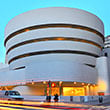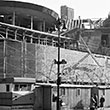Solomon R. Guggenheim Museum
Solomon R. Guggenheim Museum
The Solomon R. Guggenheim Museum in New York City, widely known simply as “The Guggenheim,” was the result of a long and contentious but ultimately fruitful relationship between architect Frank Lloyd Wright and his client, for whom the museum is named.
Wright, who loved nature and natural forms, was not a fan of New York City, but he acceded to his client’s wish for an urban location, and he ultimately found a way to bring organic inspiration into the museum design. Unlike the box-shaped galleries of traditional museums, this nautilus-shaped building, constructed of reinforced concrete, moves visitors seamlessly along a long, spiraling ramp.
Described by Wright as an “inverted ziggurat,” the building stands out dramatically on Fifth Avenue.
Six months before the museum opened in October 1959, Wright died at age 92.







